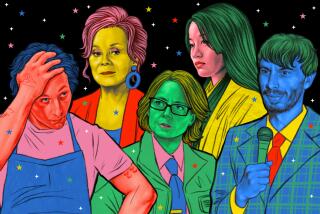Could Don Draper sell this?
- Share via
Most television viewers know AMC, if they know it at all, as a repository of old Hollywood movies. But the cable channel made history Thursday morning -- and startled industry observers -- when it received 16 nominations for its acclaimed drama series “Mad Men.”
A stylish New York period piece about the Madison Avenue ad business during JFK-era America, complete with poodle skirts and smoke-filled offices, “Mad Men” was the most-honored of any drama series this year, a surprising achievement given that it represented AMC’s first real stab at traditional series development.
It was only the latest stop in “Mad Men’s” astonishing trip from a spec script hammered out by a moonlighting TV writer to cultural phenomenon, critics’ darling and Golden Globe winner. A promotional campaign worth an estimated $25 million is pushing the show’s return for Season 2 on July 27, including elaborate window displays at Bloomingdale’s in New York and a huge “wallscape” at the Hollywood & Highland complex in Los Angeles.
Too bad, then, that about 98% of Americans have never watched the show.
In fact, whatever the interest in this acting showdown or that snub, this year’s Emmy nominations may be most notable for underscoring a growing cultural trend: the yawning gap between what critics and industry veterans cherish and what the rest of the public actually watches. It’s the relentless narrowing of what was once, in a pre-Internet era, a mass culture, a shift that mirrors what’s happening in movies, books and other art forms.
“In terms of nominations, it is a very elite group,” said Shari Anne Brill, an analyst at New York-based ad firm Carat. Referring to today’s most-honored TV shows, she added: “They get an upscale audience; they just don’t get a mass audience.”
Scripted series, from “I Love Lucy” to “Dallas” to “Friends,” traditionally netted some of the biggest audiences in television history. But now TV’s comedies and dramas are, with a sprinkling of exceptions, becoming expensive diversions for the cultural elite, akin to opera in the 19th century or foreign films in the 1960s. Critics may love shows such as “Mad Men,” FX’s “Damages” (seven nominations) and HBO’s “The Wire,” but not many other Americans have caught the fever. Even popular network dramas such as ABC’s “Lost” and NBC’s “Heroes” have far fewer viewers than comparable series even a few years ago.
Instead, the TV masses tend to flock these days to major sporting events -- such as February’s Super Bowl telecast on Fox, which drew a record audience of 97.5 million -- and live reality shows such as “American Idol” or “Dancing With the Stars.” The latter were Emmy-nominated but mostly in the relatively low-prestige “reality competition” category.
“On broadcast networks, they have to speak to a lower common denominator,” said Glenn Close, nominated for her star turn as a high-powered attorney on FX’s thriller “Damages.”
Cable can offer actors and producers much more freedom -- in part because the channels can live with far fewer viewers. Cable networks generally spend less on programs than do their broadcast counterparts, although the disparity is not as wide as it once was. Also, cable outlets make money from subscriber fees collected by cable and satellite companies, in addition to commercials bought by advertisers.
During its first season last summer, “Mad Men” averaged about 1 million total viewers, according to Nielsen Media Research. That’s a very modest figure even in today’s fragmented media universe, and a fraction of the nearly 30 million viewers routinely gathered by Fox’s top-rated singing contest, “American Idol.”
But “Mad Men” is hardly the only Emmy honoree starving for an audience. The field of best-drama nominees includes only one show with an indisputably big audience -- Fox’s medical show “House” -- along with such little-seen series as Showtime’s serial-killer drama “Dexter” (which drew wider exposure when edited repeats ran on CBS) and “Damages.” The dominance of smaller fry holds up in the comedy category as well, where ratings-deprived shows such as NBC’s “30 Rock” (last year’s winner) and HBO’s “Curb Your Enthusiasm” coexist alongside TV’s No. 1 comedy, CBS’ “Two and a Half Men.”
The disconnect could wind up having a huge effect on TV programming, as well as on the Emmys themselves. As more cable outlets follow the lead of HBO, FX and now AMC in making original scripted programming, the traditional broadcasters push for more sports, live specials and reality shows.
Meanwhile, ratings for the annual Emmy telecast, which have been declining for years, may erode further as the TV academy honors rarefied series. This year’s Academy Awards slipped to a record low as homage was paid to a batch of acclaimed but little-seen films, including the best picture winner, “No Country for Old Men.”
Many industry veterans make the argument that ratings simply don’t mean what they used to, not in an era when most households get more than 100 channels and when increasing numbers of viewers are watching television shows on digital video recorders, portable devices or their computers.
“Ratings are a very complex thing in the modern day,” said Matthew Weiner, executive producer of “Mad Men,” who wrote the pilot script in his spare time while toiling as a writer for CBS’ sitcom “Becker.” The show’s second season, coming later this month, will include DVR-adjusted ratings for the first time, Weiner said. Factoring in a DVR audience can boost a show’s ratings by as much as 25%, which in the case of “Mad Men” would translate to an extra 250,000 viewers.
Charlie Collier, AMC’s general manager, noted that, while “Mad Men” may have a small overall audience, it’s an affluent one, and therefore desirable to advertisers. The show “was meant to speak to an upscale audience looking for a patient, well-told story,” he said.
Perhaps most important, some industry watchers who have been sharply critical of Emmy choices in the past feel the voters got it right this time -- even if that meant giving a nod to programs that a statistically negligible number of Americans have actually seen.
“This year, I really agree with a lot of the choices,” said Carat’s Brill. “It’s supposed to be an award show about artistry, not a popularity contest.”
--
Times staff writer Matea Gold contributed to this report.
More to Read
The complete guide to home viewing
Get Screen Gab for everything about the TV shows and streaming movies everyone’s talking about.
You may occasionally receive promotional content from the Los Angeles Times.







